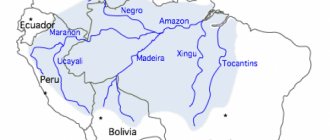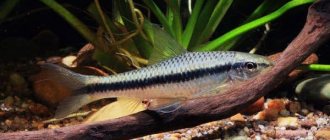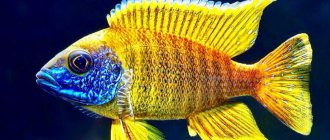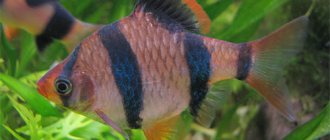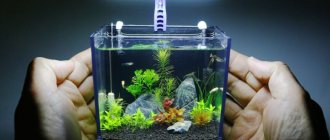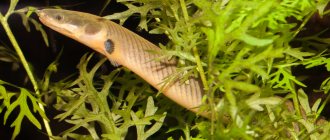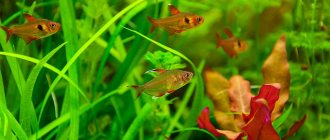Neons are small aquarium fish suitable for breeding at home. Young individuals are capable of producing offspring as early as 7-8 months. Reproductive function lasts up to 5 years. Neon fish reproduce by spawning. The most suitable time for spawning is from the beginning of October to the end of January.
It is quite difficult to breed blue neons in an aquarium, because they are not viviparous, but spawning fish.
Preparing for spawning
First, strong, healthy males and females with characteristics characteristic of the species are selected. The fish should be active, and their coloring should be typical of adults. Externally, individuals of both sexes differ. Males are smaller, have a flat stomach, and a straight neon stripe running down their body. The females are larger, their stripe is not straight, but with a break in the middle, the belly has a rounded shape, especially on the eve of spawning.
The species is not viviparous , but lays eggs.
If the conditions are met, the male can release milk once every 2 weeks, and the females spawn once every 7 days. Neon aquarium fish, ready for reproduction, acquire characteristic characteristics. The abdomen of females becomes larger and rounder, and in males the swim bladder is clearly visible, moving closer to the anus. Read more: description of the swim air bladder in fish.
13-15 days before the expected spawning, the selected producers are placed in different aquariums or jars of water. At this time, they should be fed very well, adding to the diet:
- small bloodworms;
- cyclops;
- Daphnia
Tubifex and Enchytraeus should not be given. Caring for fish comes down to maintaining the temperature at 20 degrees.
Spawning in neons can last for several days.
How to distinguish a boy and a girl
Before the breeding period (12-14 days), the owner must carefully observe his pets, select a suitable pair and transplant them into another container. But you should be especially careful not to accidentally put two males or females into a spawning tank.
Sex differences in fish are noticeable, but may not be obvious to an inexperienced owner. Female neons are much larger than males. The latter have a straighter neon line with virtually no bends. Neons are not viviparous, they lay eggs, so the female, whose eggs have matured inside, is rounder and has a large belly. During the breeding season, males have a clearly visible swim bladder.
We recommend reading
About diseases of betta fish
Next, the owner should choose the most suitable pair for spawning.
Arrangement of the spawning area
Breeding neons in a community aquarium is not recommended, since eggs and fry require a special microclimate. It is better if the female spawns in a separate container. The spawning ground is set up while future producers are fattening.
Neon fish reproduce best in an aquarium about 40 cm long, but you can also take a glass jar. The main requirement for the container is that it should be convenient to disinfect and wash. First, the aquarium or jar is treated with a weak solution of potassium permanganate, then thoroughly washed with boiled water.
During spawning, the container should not be too light, so the walls are shaded in advance with a thin cloth or newsprint. It is optimal if dim light gets inside. The top of the container does not need to be covered with paper to make it convenient to observe the behavior and condition of the fish. But it is advisable to put a piece of glass, because neons are very active during spawning, and it is possible that the fish will jump out and die. There should be no soil at the bottom of the spawning area. Instead, put one of the following:
- Java moss;
- fern plants;
- twigs of cryptorina;
- bast;
- willow roots;
- tangled fishing line;
- nylon net.
There should be no other fish species in the spawning area. Snails and catfish are especially dangerous for eggs, as they can destroy all offspring in a short time.
What do neons cause?
Fish can get sick from virtually all types of contagious and non-contagious diseases. Neons, being small and fragile fish, do not tolerate stress well (for example, if they are chased by “bad neighbors”), as well as uncomfortable water parameters and the lack of a school lifestyle - which, taken together and individually, can lead to diseases (for example, ichthyophthirosis - decoy). Neons have a disease unique to them - plistophorosis, or also called “neon disease”. This infection manifests itself in the form of fading areas on the body of fish - in neon, blue and red stripes fade.
The disease is virtually incurable!
Water composition
The water in the container where spawning will occur must be purified and soft. A mixture of aquarium water and distilled water is suitable. You can also use tap water, but it should be collected several days in advance and then kept at room temperature. Tap water contains harmful impurities, and during settling they evaporate. Water is poured into the spawning area at a temperature of no lower than 22 and no higher than 25 degrees.
Water hardness is very important for successful fertilization. This indicator should have a value from 0.5 to 4, best of all - about 1. Optimal acidity - 5.5-6 units. With these parameters, bacteria practically do not multiply, and the eggs are in comfortable conditions. You can increase the acidity level of water by adding a decoction of one of the components:
- peat;
- alder cones;
- oak bark.
You can also buy a special acidifying agent at the pet store.
Selection of partners
The highest productivity is observed in neons aged 10-12 months. 1 female and 2-3 males are placed in the tank where the spawning will take place. For successful reproduction, you need to choose the right fish and know how to distinguish a female from a male.
Males are smaller in size than females. Their body length is 0.5 cm shorter. They are more slender, unlike large and pot-bellied females. A pregnant neon, a female carrying eggs, enlarges even more in the abdominal area immediately before spawning; the male’s swim bladder becomes more pronounced.
For breeding to be successful, you need to select only those individuals that meet the following parameters:
- appearance – active fish, healthy, without torn fins or other similar nuances;
- color – rich, bright, juicy;
- behavior - playful, curious, good appetite.
During the 2-week period of fish relocation, it is not recommended to give them tubifex. This type of live food contains a lot of fat, which can negatively affect the health of the fish and their future offspring.
Calf throwing
The female and male are dropped into the spawning area in the evening, and after that they are not given food. You can use either one male or two. In the second case, the eggs will be fertilized by a stronger neon male. Spawning begins in the morning and ends after about 4 hours. During spawning, the female moves chaotically and lays eggs, with the total number of eggs reaching 100–300. The male follows her and performs fertilization. The eggs descend and attach to algae or pebbles.
Immediately after the end of spawning, the fish should be placed in a common aquarium. If this is not done, they will eat the eggs. For the same reason, breeding in a community aquarium is not recommended: parents can destroy their offspring. After spawning, the water should be disinfected so that bacteria do not multiply in it and fungus does not develop.
For this purpose, add one of the drugs:
- General Tonic;
- "Tripaflavin";
- "Methylene blue."
After disinfection, the container is covered with a cloth or other opaque material and placed in a dark place. If you don't do this. the eggs will die because they cannot tolerate light.
To breed fish, it is necessary to create special conditions: use all-glass jars that are easy to wash and disinfect.
Description
Paracheirodon axelrodi is a species of ray-finned fish that lives in the fresh waters of tropical forests and belongs to the Characin family. First described by Schultz in 1956, 20 years after the discovery of blue neon. Its natural habitat is the slow rivers and lakes of South America. They live in a school of 10 fish or more. They prefer the middle layers of reservoirs and rarely swim near the bottom and surface.
They are prone to neon disease, which affects the integument of the body and discolors it. Leads to the death of fish.
Appearance
Red neon is often confused with its relative, blue neon. An inexperienced person really won’t be able to tell them apart at first glance, because they look similar in color.
| Red neon | Blue neon |
| A blue line on the body runs along the upper middle of the body from the mouth to the base of the tail. | A blue stripe extends across the entire upper body from the mouth and ends just beyond the dorsal fin. |
| A bright red line occupies the entire lower part from the bottom of the head to the tail. | The red stripe starts from the middle of the body on the abdomen and ends near the base of the tail. |
| Larger size. | Smaller size. |
| Requires more careful care. | Unpretentious. |
The body length of females does not exceed 5 cm, and males 3 cm. Their upper back is not brightly colored, but has a beige color, and the abdomen is olive-white. The fins and tail are transparent.
This type of fish belongs to school animals, therefore, without company, they feel uncomfortable alone, some are prone to death, so the minimum number of fish in the aquarium is 5 pieces.
They do not differ in aggressive character and behavior. Therefore, they get along with fish who are neutral towards them. They experience stress when they are around large fish.
In the natural environment, their lifespan does not exceed one and a half years, but when cared for in an aquarium, they live up to 5 years without disease or hunger.
Appearance of fry
A day after the completion of spawning, the larvae hatch. Without waiting for this process, you should inspect the eggs and remove those that have a whitish color and opaque structure. These are dead specimens, nothing will hatch from them, and if you leave them in the spawning area, the water will be spoiled.
For the first 4 days, the fry sit motionless, feeding on what is in the yolk sac. When its contents run out, which happens around the fifth day, the babies begin to move around in search of food. At this time, you can already feed them zooplankton.
During the first month of life, the fry have poor orientation, but they have developed phototaxis. Thanks to this feature, the fish feel where the illuminated areas are. Thus, you need to darken almost the entire container, leaving a small part open. Plankton will accumulate in the light, which young neons readily eat.
All types of neon
Neon blue or common (Paracheirodon innesi)
The most popular among neons. These neons have amazingly bright colors. There is a beautiful turquoise-blue neon stripe running along the entire top, and half of the lower part of the body is deep red, the back is grayish-brown, and all the fins are transparent. They differ from their counterparts in their elongated, long body shape. Blue neon females are 4 cm, males are 3.5 cm.
Feeding babies
Little neons eat often, but little by little, so you shouldn’t give them large portions at a time. In the first days they consume plankton, then their diet is gradually diversified. Suitable food for fish:
- rotifers;
- zooplankton;
- ciliates;
- hard-boiled and mashed egg yolk;
- cyclops;
- nauplii.
The darkening from the spawning area is removed when the fish are 2 weeks old. After another 7 days, the neon chips acquire a characteristic shine. By the age of one month, the fish should get used to normal lighting, and at 1.5 months they are transferred to water with normal hardness. At this time, it is already possible to plant neon babies in the aquarium, having previously accustomed them to new food.
Content
The main condition for keeping red neons is a flock of 7–20 representatives. Otherwise, they are unpretentious and caring for them is no different from other neons.
Aquarium
The size of the aquarium ranges from 20 to 60 liters, depending on the number of schools and the population density of the remaining fish. Fish like to swim quickly in schools, so it is better to choose an elongated aquarium rather than a tall one. Be sure to equip it with a lid, neons easily jump out of the water.
Water parameters
Comfortable water temperature is 21–27 degrees, but it is better to lean towards a lower temperature, because this prolongs the lifespan. Water hardness 5–6 dGH. They prefer acidified water, which helps the color to be brighter.
Plants
Neons love to swim among a lot of vegetation, so plant Java moss, Echinodorus, and fern around the edges of the aquarium. They do not spoil the foliage and roots of plants, so you don’t have to worry about the condition of the vegetation.
For the ground, dark themes are often chosen, in which the color of the neons appears brighter. Suitable substrates include river sand, small pebbles and gravel. For shelter, driftwood and clay pots are placed on the bottom.
Equipment
Although neons are unpretentious, they require an aerator to enrich the water with oxygen, and a compressor to remove food debris and fish waste, keeping the aquarium clean.
Lighting
Too bright lighting makes neon people nervous; they feel safe in shaded areas or with diffuse lighting. In a dark tank their color looks brighter.
Feeding
These fish are not picky about food; they feed on live, dry, and frozen food. In nature, their diet consists of crustaceans, insect larvae, and worms. The size of the food granules must be suitable for the size of the fish's mouth so that it swallows it.
Feeding time for the flock does not exceed 5 minutes and is carried out 2 times a day. But if possible, feed more often, but in smaller doses, so that the food is eaten in 2 minutes.
Compatibility
The most successful option for the neighborhood of red neons would be a society of similar fish, because schooling helped them survive. But they do well with other species if the fish do not harm them. Neons and small fish like rasboras, labyrinths, dwarf cichlids, corydoras catfishes, nannostomuses, and erythrosonos are compatible. The size of neighbors should not exceed the size of neons, and ideally be even smaller.
All large species of fish that can swallow neon are not suitable for living together, this especially applies to predators, aggressive and territorial fish. Even if they don't ingest the red neon, they will create a stressful environment for the fish. These include cichlids, discus, bettas, goldfish, angelfish, astronotus, acara, and cichlids.
Caring for spawners after spawning
The male and female should rest for 4-5 months after spawning. Let them sit in the same aquarium, but you should limit their diet by removing tubifex and enchytraea from the diet. Instead of this high-calorie food, they give more cyclops and daphnia. The water in the aquarium should have a temperature of about 17−19 °C.
For spawning you need to provide diffused lighting.
Thus, it is not difficult to breed neons at home. By giving these fish care and attention, the aquarist will be rewarded with strong and healthy offspring.
Compatibility
They get along with almost all fish. The exception is large predatory and aggressive individuals, whose diet includes only meat. Barbs, cichlids, and tetradons get irritated at the sight of colorful, bright neighbors. Therefore, in an aquarium where pets of different characters live, shelters are needed where the fish can hide if a threat arises. Neons, catfish, gouramis, nanostomas and peace-loving guppies get along well with each other. Despite the fact that Neons feel comfortable only in a flock, during the mating season the males engage in serious battles for females, during which scales and fins may be damaged.
